COVID-19 Induced Changes in Residual Municipal Waste Management in Provincial Territories of the Marche Region (Italy): Flow Analysis and Environmental Assessment
Abstract
1. Introduction
2. Materials and Methods
2.1. Provincial Territories and Scenarios
2.2. Data Collection and Elaboration for Waste Flow Analysis
2.3. LCA
2.3.1. Goal and Scope Definition
2.3.2. Inventory Analysis
Pre-COVID-19 Scenario
COVID-19 Scenario
2.3.3. Impact Assessment Method
3. Results and Discussion
3.1. Comparison of Waste Flows in the Considered Scenarios
3.1.1. Main Separately Collected MW Fractions
3.1.2. RMW
3.2. Comparison of LCIA in the Considered Scenarios
Contribution Analysis
4. Conclusions
Supplementary Materials
Author Contributions
Funding
Data Availability Statement
Acknowledgments
Conflicts of Interest
References
- Chakraborty, I.; Maity, P. COVID-19 outbreak: Migration, effects on society, global environment and prevention. Sci. Total Environ. 2020, 728, 138882. [Google Scholar] [CrossRef] [PubMed]
- WHO (World Health Organisation). WHO Director-General’s Opening Remarks at the Media Briefing on COVID-19—11 March 2020. Available online: https://www.who.int/director-general/speeches/detail/who-director-general-s-opening-remarks-at-the-media-briefing-on-covid-19---11-march-2020 (accessed on 1 February 2024).
- Singer, B.J.; Thompson, R.N.; Bonsall, M.B. The effect of the definition of “pandemic” on quantitative assessments of infectious disease outbreak risk. Sci. Rep. 2021, 11, 2547. [Google Scholar] [CrossRef] [PubMed]
- Das, A.K.; Islam, M.N.; Billah, M.M.; Sarker, A. COVID-19 and municipal solid waste (MSW) management: A review. Environ. Sci. Pollut. Res. 2021, 28, 28993–29008. [Google Scholar] [CrossRef] [PubMed]
- Di Maria, F.; Beccaloni, E.; Bonadonna, L.; Cini, C.; Confalonieri, E.; La Rosa, G.; Milana, M.R.; Testai, E.; Scaini, F. Minimization of spreading of SARS-CoV-2 via household waste produced by subjects affected by COVID-19 or in quarantine. Sci. Total Environ. 2020, 743, 140803. [Google Scholar] [CrossRef]
- Filho, W.L.; Voronova, V.; Kloga, M.; Paço, A.; Minhas, A.; Salvia, A.L.; Ferreira, C.D.; Sivapalan, S. COVID-19 and waste production in households: A trend analysis. Sci. Total Environ. 2021, 777, 145997. [Google Scholar] [CrossRef]
- Kulkarni, B.N.; Anantharama, V. Repercussions of COVID-19 pandemic on municipal solid waste management: Challenges and opportunities. Sci. Total Environ. 2020, 743, 140693. [Google Scholar] [CrossRef]
- Nghiem, L.D.; Morgan, B.; Donner, E.; Short, M.D. The COVID-19 pandemic: Considerations for the waste and wastewater services sector. Case Stud. Chem. Environ. Eng. 2020, 1, 100006. [Google Scholar] [CrossRef]
- Fan, Y.V.; Jiang, P.; Hemzal, M.; Klemeš, J.J. An update of COVID-19 influence on waste management. Sci. Total Environ. 2021, 754, 142014. [Google Scholar] [CrossRef]
- Dente, S.M.R.; Hashimoto, S. COVID-19: A pandemic with positive and negative outcomes on resource and waste flows and stocks. Resour. Conserv. Recycl. 2020, 161, 104979. [Google Scholar] [CrossRef]
- Ragazzi, M.; Rada, E.C.; Schiavon, M. Municipal solid waste management during the SARS-CoV-2 outbreak and lockdown ease: Lessons from Italy. Sci. Total Environ. 2020, 745, 141159. [Google Scholar] [CrossRef]
- Saadat, S.; Rawtani, D.; Hussain, C.M. Environmental perspective of COVID-19. Sci. Total Environ. 2020, 728, 138870. [Google Scholar] [CrossRef] [PubMed]
- Christensen, T.H. Industrial waste. In Solid Waste Technology & Management; Christensen, T.H., Ed.; John Wiley & Sons Ltd.: Chichester, UK, 2010; Volume 1, pp. 100–103. [Google Scholar]
- European Parliament and Council of the European Union. Directive (EU) 2018/851 of the European Parliament and of the Council of 30 May 2018 amending Directive 2008/98/EC on waste. Off. J. Eur. Union 2018, L 150, 109–140.
- van Straten, B.; Ligtelijn, S.; Droog, L.; Putman, E.; Dankelman, J.; Sperna Weiland, N.H.; Horeman, T. A life cycle assessment of reprocessing face masks during the COVID-19 pandemic. Sci. Rep. 2021, 11, 17680. [Google Scholar] [CrossRef] [PubMed]
- Ajaj, R.; Dweik, R.A.; Syed Ali, S.A.; Stietiya, M.H. Life cycle assessment studies to evaluate the sustainability of various facemasks used during COVID-19: A UAE case study. J. Environ. Chem. Eng. 2023, 11, 110491. [Google Scholar] [CrossRef]
- Maceno, M.M.C.; João, S.; Voltolini, D.R.; Zattar, I.C. Life cycle assessment and circularity evaluation of the non-medical masks in the COVID-19 pandemic: A Brazilian case. Environ. Dev. Sustain. 2023, 25, 8055–8082. [Google Scholar] [CrossRef]
- Zhao, H.; Liu, H.; Wei, G.; Wang, H.; Zhu, Y.; Zhang, R.; Yang, Y. Comparative life cycle assessment of emergency disposal scenarios for medical waste during the COVID-19 pandemic in China. Waste Manag. 2021, 126, 388–399. [Google Scholar] [CrossRef]
- Lu, D.; Iqbal, A.; Zan, F.; Liu, X.; Dong, Z.; Jiang, C.; Chen, G. Integrated life cycle assessment with data envelopment analysis for enhancing medical waste management during a public health crisis. J. Clean. Prod. 2023, 426, 139074. [Google Scholar] [CrossRef]
- Belhadi, A.; Kamble, S.S.; Khan, S.A.R.; Touriki, F.E.; Kumar, D.M. Infectious waste management strategy during COVID-19 pandemic in Africa: An integrated decision-making framework for selecting sustainable technologies. Environ. Manag. 2020, 66, 1085–1104. [Google Scholar] [CrossRef]
- Shekoohiyan, S.; Hadadian, M.; Heidari, M.; Hosseinzadeh-Bandbafha, M. Life cycle assessment of Tehran municipal solid waste during the COVID-19 pandemic and environmental impacts prediction using machine learning. Case Stud. Chem. Environ. Eng. 2023, 7, 100331. [Google Scholar] [CrossRef]
- Colvero, D.A.; Pfeiffer, S.C.; Ramalho, J.C.M.; do Nascimento, A.A.; de Lima, A.C.A. Identification of environmental impacts associated with municipal solid waste management through life cycle assessment. Int. J. Environ. Sci. Technol. 2024, 1–18. [Google Scholar] [CrossRef]
- Aldaco, R.; Hoehn, D.; Laso, J.; Margallo, M.; Ruiz-Salmón, J.; Cristobal, J.; Kahhat, R.; Villanueva-Rey, P.; Bala, A.; Batlle-Bayer, L.; et al. Food waste management during the COVID-19 outbreak: A holistic climate, economic and nutritional approach. Sci. Total Environ. 2020, 742, 140524. [Google Scholar] [CrossRef] [PubMed]
- Italian President of the Council of Ministers. Decree of 1 March 2020 on urgent measures in containing and managing the COVID-19 epidemic emergency. Ital. Off. Gaz. 2020, 52, 1–6. (In Italian) [Google Scholar]
- ISPRA (Italian Institute for Environmental Protection and Research). Municipal Waste Report—Edition 2023; Report Series No. 393/2023; ISPRA: Rome, Italy, 2023. (In Italian)
- ISTAT (Italian National Institute of Statistics). The Extensions of Italian Municipalities, Provinces, and Regions; Report; ISTAT: Rome, Italy, 2013. (In Italian)
- ARPAM (Environmental Protection Agency of the Marche Region). Annual Report on Municipal Waste in the Marche Region. 2019; Boccarossa, M., Ed.; ARPAM: Pesaro, Italy, 2020. (In Italian)
- ARPAM. Annual Report on Municipal Waste in the Marche Region 2020; Boccarossa, M., Ed.; ARPAM: Pesaro, Italy, 2021. (In Italian)
- European Commission. Commission Decision of 18 December 2014 amending Decision 2000/532/EC on the list of waste pursuant to Directive 2008/98/EC of the European Parliament and of the Council. Off. J. Eur. Union 2014, L 370, 44–86.
- Carchesio, M.; Di Addario, M.; Tatàno, F.; de Rosa, S.; Gambioli, A. Evaluation of the biochemical methane potential of residual organic fraction and mechanically-biologically treated organic outputs intended for landfilling. Waste Manag. 2020, 113, 20–31. [Google Scholar] [CrossRef] [PubMed]
- Boccarossa, M.; Di Addario, M.; Folino, A.; Tatàno, F. Scenarios of bioenergy recovery from organic fraction of residual municipal waste in the Marche Region (Italy). Sustainability 2021, 13, 11462. [Google Scholar] [CrossRef]
- European Commission. Waste Management in the Context of the Coronavirus Crisis; European Commission: Brussels, Belgium, 2020.
- ISS (Italian National Institute of Health). Interim Guidance to Manage Municipal Waste Related to the Transmission of the SARS-CoV-2 Virus Infection; Report Series ISS COVID-19 No. 3/2020, rev. 2; ISS: Rome, Italy, 2020. (In Italian) [Google Scholar]
- ECDC (European Centre for Disease Prevention and Control). Infection Prevention and Control in the Household Management of People with Suspected or Confirmed Coronavirus Disease (COVID-19); ECDC Technical Report; ECDC: Stockholm, Sweden, 2020.
- President of the Marche Region. Decree No. 13 of 21 March 2020 on Urgent Measures to Manage the Municipal Waste in the COVID-19 Epidemic Emergency; Marche Region: Ancona, Italy, 2020; Available online: https://www.regione.marche.it/ars/Aree-di-Attività/Coronavirus/Normativa-regionale (accessed on 1 February 2024). (In Italian)
- President of the Marche Region. Decree No. 23 of 24 April 2020 on Further Measures to Manage the Municipal Waste in the COVID-19 Epidemic Emergency; Marche Region: Ancona, Italy, 2020; Available online: https://www.regione.marche.it/ars/Aree-di-Attività/Coronavirus/Normativa-regionale (accessed on 1 February 2024). (In Italian)
- Province of Macerata. Permit on Integration Pollution Prevention and Control for the Installation of Treatment Plant for Non-Hazardous Waste in the Municipality of Tolentino; Decision No. 150—Section 10; Province of Macerata: Macerata, Italy, 2016; Available online: https://istituzionale.provincia.mc.it/avvisi-cms/elenco-autorizzazioni-integrate-ambientali/ (accessed on 1 February 2024). (In Italian)
- Sauve, S.; Van Acker, K. The environmental impacts of municipal solid waste landfills in Europe: A life cycle assessment of proper reference cases to support decision making. J. Environ. Manag. 2020, 261, 110216. [Google Scholar] [CrossRef]
- Rigamonti, L.; Grosso, M.; Biganzoli, L. Environmental assessment of refuse-derived fuel co-combustion in a coal-fired power plant. J. Ind. Ecol. 2012, 16, 748–760. [Google Scholar] [CrossRef]
- Fiorentino, G.; Ripa, M.; Protano, G.; Hornsby, C.; Ulgiati, S. Life cycle assessment of mixed municipal solid waste: Multi-input versus multi-output perspective. Waste Manag. 2015, 46, 599–611. [Google Scholar] [CrossRef]
- Mancini, G.; Lombardi, L.; Luciano, A.; Bolzonella, D.; Viotti, P.; Fino, D. A reduction in global impacts through a waste-wastewater-energy nexus: A life cycle assessment. Energy 2024, 289, 130020. [Google Scholar] [CrossRef]
- ARPAM. The Role of the Environmental Protection Agency of the Marche Region in Elaboration of Waste Data; Boccarossa, M., Ed.; ARPAM: Pesaro, Italy, 2016. Available online: https://www.arpa.marche.it/temi-ambientali/2012-06-12-08-52-59 (accessed on 1 February 2024). (In Italian)
- ISO 14040; Environmental Management—Life Cycle Assessment—Principles and Framework. ISO: Geneva, Switzerland, 2006.
- ISO 14044; Environmental Management—Life Cycle Assessment—Requirements and Guidelines. ISO: Geneva, Switzerland, 2006.
- Ardolino, F.; Berto, C.; Arena, U. Environmental performances of different configurations of a material recovery facility in a life cycle perspective. Waste Manag. 2017, 68, 662–676. [Google Scholar] [CrossRef]
- Avadí, A.; Aissani, L.; Pradel, M.; Wilfart, A. Life cycle inventory data on French organic waste treatments yielding organic amendments and fertilisers. Data Brief 2020, 28, 105000. [Google Scholar] [CrossRef] [PubMed]
- COSMARI. Environmental Statement for the Year 2019 according to the Commission Regulation (EU) 2018/2026; COSMARI: Tolentino, Italy, 2020. (In Italian) [Google Scholar]
- ASET. Annual Report 2019 for the Controlled Landfill for Non-hazardous Waste in Fano Town District; Farina, D., Ed.; ASET: Fano, Italy, 2020. (In Italian) [Google Scholar]
- Marche Multiservizi. Annual Report 2019 for the Controlled Landfill for Non-hazardous Waste in Pesaro Town District; Farina, D., Ed.; Marche Multiservizi: Pesaro, Italy, 2020. (In Italian) [Google Scholar]
- Marche Multiservizi. Annual Report 2019 for the Controlled Landfill for Non-hazardous Waste in Urbino Town District; Cioppi, L., Ed.; Marche Multiservizi: Pesaro, Italy, 2020. (In Italian) [Google Scholar]
- Christensen, T.H.; Kjeldsen, P.; Bjerg, P.L.; Jensen, D.L.; Christensen, J.B.; Baun, A.; Albrechtsen, H.J.; Heron, G. Biogeochemistry of landfill leachate plumes. Appl. Geochem. 2001, 16, 659–718. [Google Scholar] [CrossRef]
- Carchesio, M.; Di Addario, M.; Tatàno, F.; de Rosa, S.; Gambioli, A. Biochemical Methane Potential of Intermediate and Final Outputs from Biostabilisation MBT. In Proceedings of the Venice 2020, 8th International Symposium on Energy from Biomass and Waste, Venice, Italy, 16–19 November 2020; CISA Publisher: Padova, Italy, 2020; pp. 1–2. [Google Scholar]
- Capaccioni, B.; Caramiello, C.; Tatàno, F.; Viscione, A. Effects of a temporary HDPE cover on landfill gas emissions: Multiyear evaluation with the static chamber approach at an Italian landfill. Waste Manag. 2011, 31, 956–965. [Google Scholar] [CrossRef] [PubMed]
- Tatàno, F.; Viscione, A.; de Rosa, S.; Corigliano, G.; Capaccioni, B. Landfill Gas Emission Monitoring with the Static, Non-stationary Chamber Method: A Long-term (2005–2016) Study at an Italian Site. In Proceedings of the Sardinia 2017, Sixteenth International Waste Management and Landfill Symposium, S. Margherita di Pula, Cagliari, Italy, 2–6 October 2017; CISA Publisher: Padova, Italy, 2017; pp. 1–17. [Google Scholar]
- Province of Pesaro-Urbino. Permit on Integration Pollution Prevention and Control for the Controlled Landfill for Non-Hazardous Waste of the Fano Town District; Decision No. 1778—07/07/2010; Province of Pesaro-Urbino: Pesaro, Italy, 2010. (In Italian) [Google Scholar]
- Engineering ToolBox. Resources, Tools and Basic Information for Engineering and Design of Technical Applications. 2001. Available online: https://www.engineeringtoolbox.com (accessed on 1 February 2024).
- Pöschl, M.; Ward, S.; Owende, P. Evaluation of energy efficiency of various biogas production and utilization pathways. Appl. Energy 2010, 87, 3305–3321. [Google Scholar] [CrossRef]
- Herambiente. Annual Report for the WtE Plant for Non-Hazardous Waste in Coriano Town District; Herambiente: Rimini, Italy, 2020. (In Italian) [Google Scholar]
- Voss, R.; Lee, R.P.; Keller, F.; Huang, Q.; Fröhling, M. Decarbonization potential and economic viability of chemical recycling for China’s transformation towards carbon neutrality: Case analysis of global warming potential and costs of municipal solid waste gasification for methanol production. Resour. Conserv. Recycl. 2024, 206, 107613. [Google Scholar] [CrossRef]
- Calì, G.; Tedde, F.; Meloni, S.; Deiana, P.; Subrizi, M.; Bassano, C. Production of Gaseous Fuels, Coal Gasification and Biomass Co-gasification; ENEA (Italian National Agency for New Technologies, Energy and Sustainable Economic Development): Rome, Italy, 2016. (In Italian)
- Bogale, W.; Viganò, F. A preliminary comparative performance evaluation of highly efficient waste-to-energy plants. Energy Procedia 2014, 45, 1315–1324. [Google Scholar] [CrossRef]
- Lombardi, L.; Carnevale, E.A. Evaluation of the environmental sustainability of different waste-to-energy plant configurations. Waste Manag. 2018, 73, 232–246. [Google Scholar] [CrossRef]
- European Commission. Commission Recommendation of 9 April 2013 on the use of common methods to measure and communicate the life cycle environmental performance of products and organisations (2013/179/EU). Off. J. Eur. Union 2013, L 124, 1–210.
- Zampori, L.; Pant, R. Suggestions for Updating the Product Environmental Footprint (PEF) Method; JRC Technical Report EUR 29682 EN.; Publications Office of the European Union: Luxembourg, 2019. [Google Scholar]
- 2B. SimaPro LCA Software for Informed Change-Makers; 2B Srl: Mogliano Veneto, Italy. Available online: https://to-be.it/en/instruments/simapro-software-di-life-cycle-assessment/ (accessed on 1 February 2020).
- Ecoinvent. The Word’s Most Transparent Life Cycle Inventory Database; Ecoinvent: Zurich, Switzerland. Available online: https://ecoinvent.org (accessed on 1 February 2020).
- Italian Territorial Cohesion Agency. COVID-19: Collection of Acts Regarding Urgent Measures on Containment and Management of the Epidemic Emergency. Available online: https://www.agenziacoesione.gov.it/covid19-atti-emergenza-epidemiologica/ (accessed on 2 May 2022). (In Italian)
- Bracale, R.; Vaccaro, C.M. Changes in food choice following restrictive measures due to COVID-19. Nutr. Metab. Cardiovasc. Dis. 2020, 30, 1423–1426. [Google Scholar] [CrossRef]
- Zambrano-Monserrate, M.A.; Ruano, M.A.; Sanchez-Alcalde, L. Indirect effects of COVID-19 on the environment. Sci. Total Environ. 2020, 728, 138813. [Google Scholar] [CrossRef]
- Hupponen, M.; Grönman, K.; Horttanainen, M. Areas on which to focus when seeking to reduce the greenhouse gas emissions of commercial waste management. A case study of a hypermarket, Finland. Waste Manag. 2018, 76, 1–18. [Google Scholar] [CrossRef]
- Starostina, V.; Damgaard, A.; Eriksen, M.K.; Christensen, T.H. Waste management in the Irkutsk region, Siberia, Russia: An environmental assessment of alternative development scenarios. Waste Manag. Res. 2018, 36, 373–385. [Google Scholar] [CrossRef]
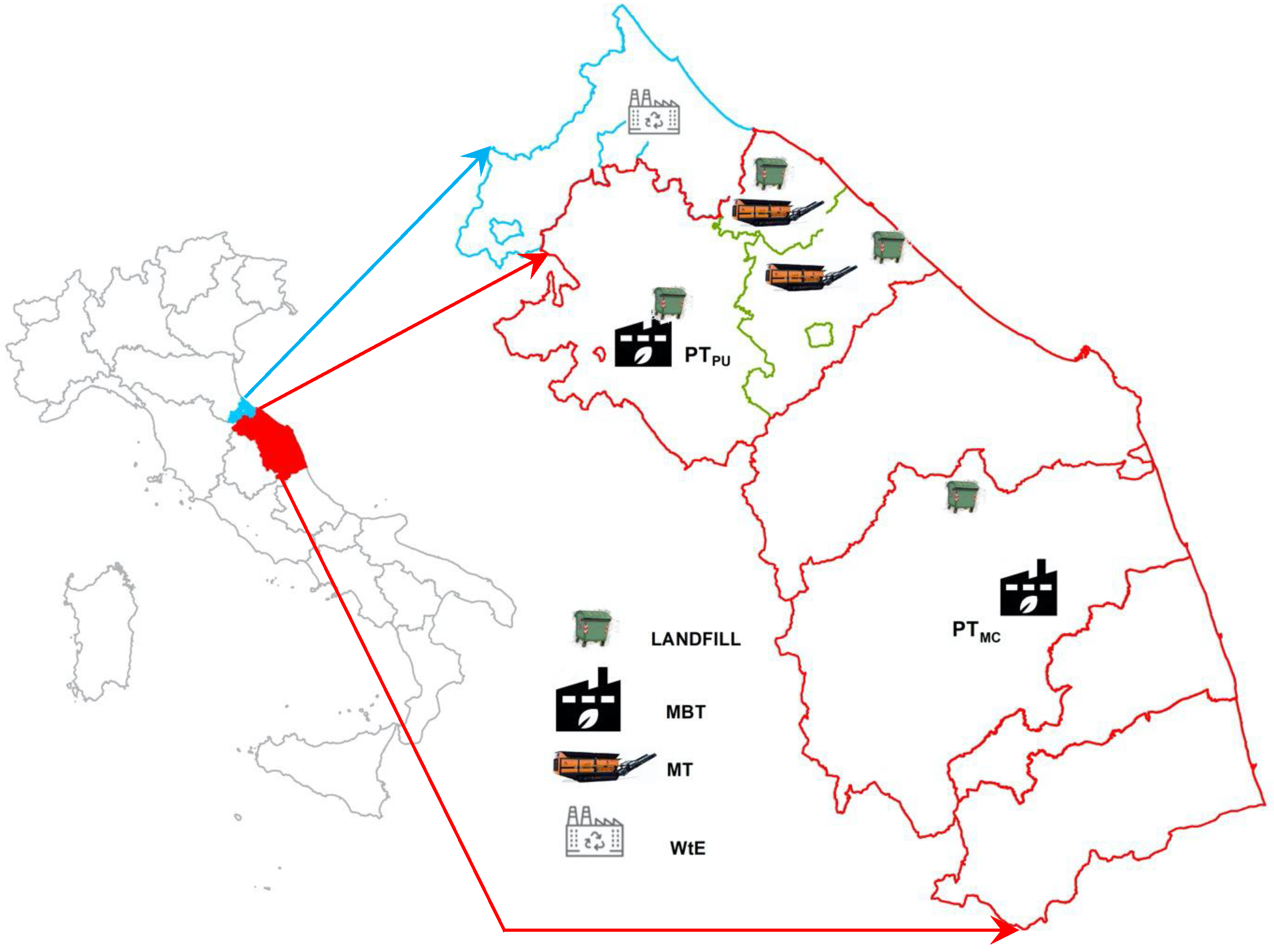
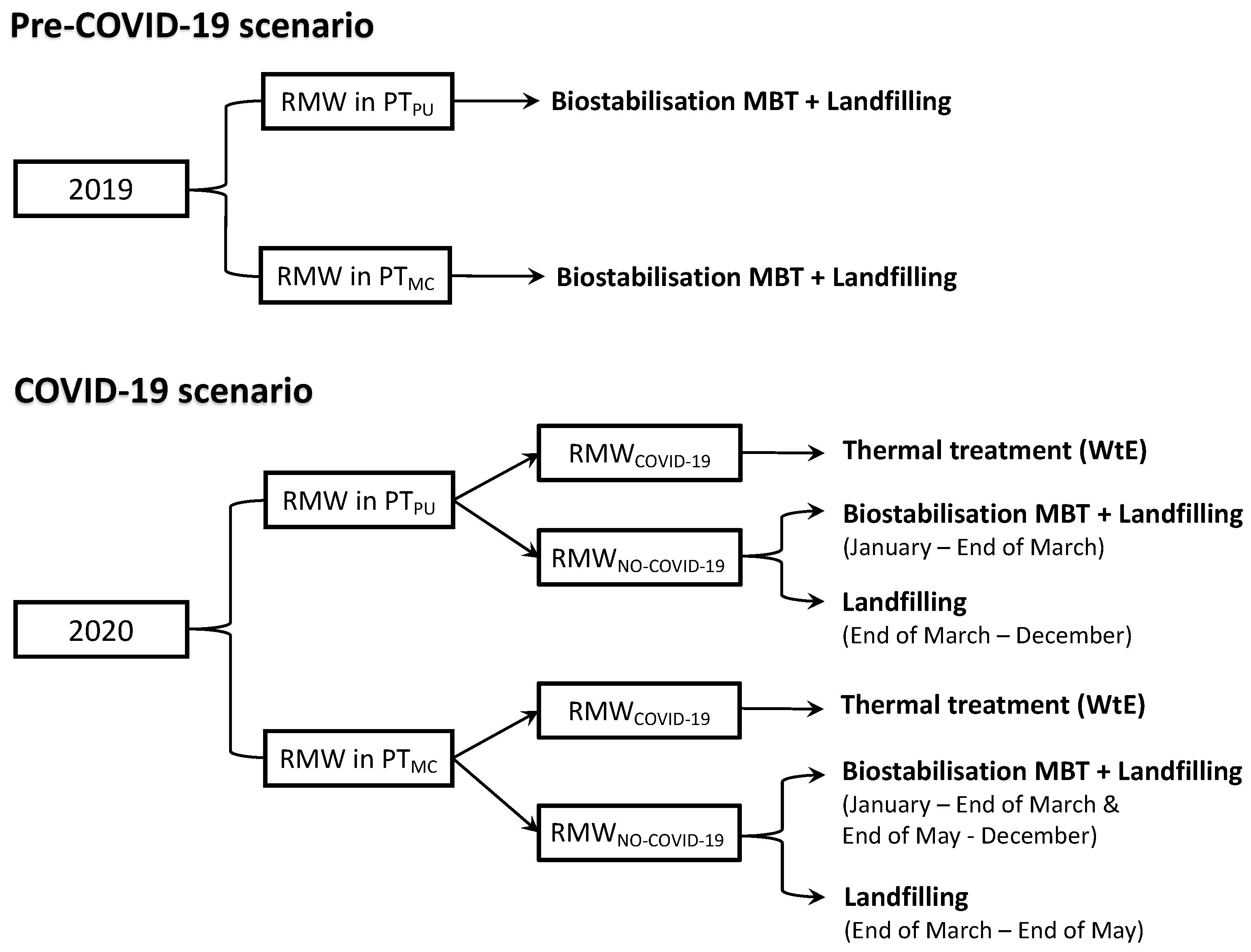
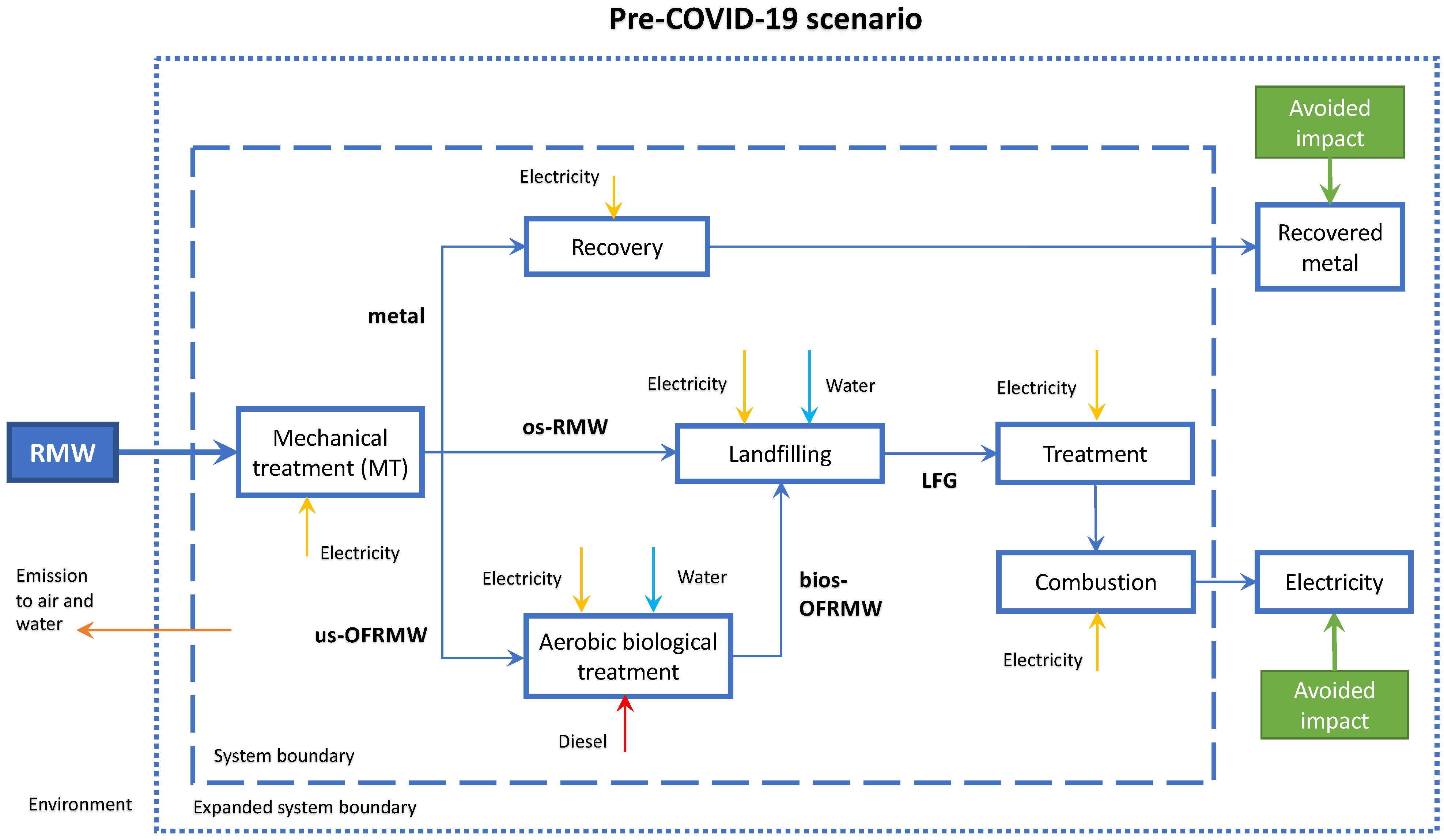
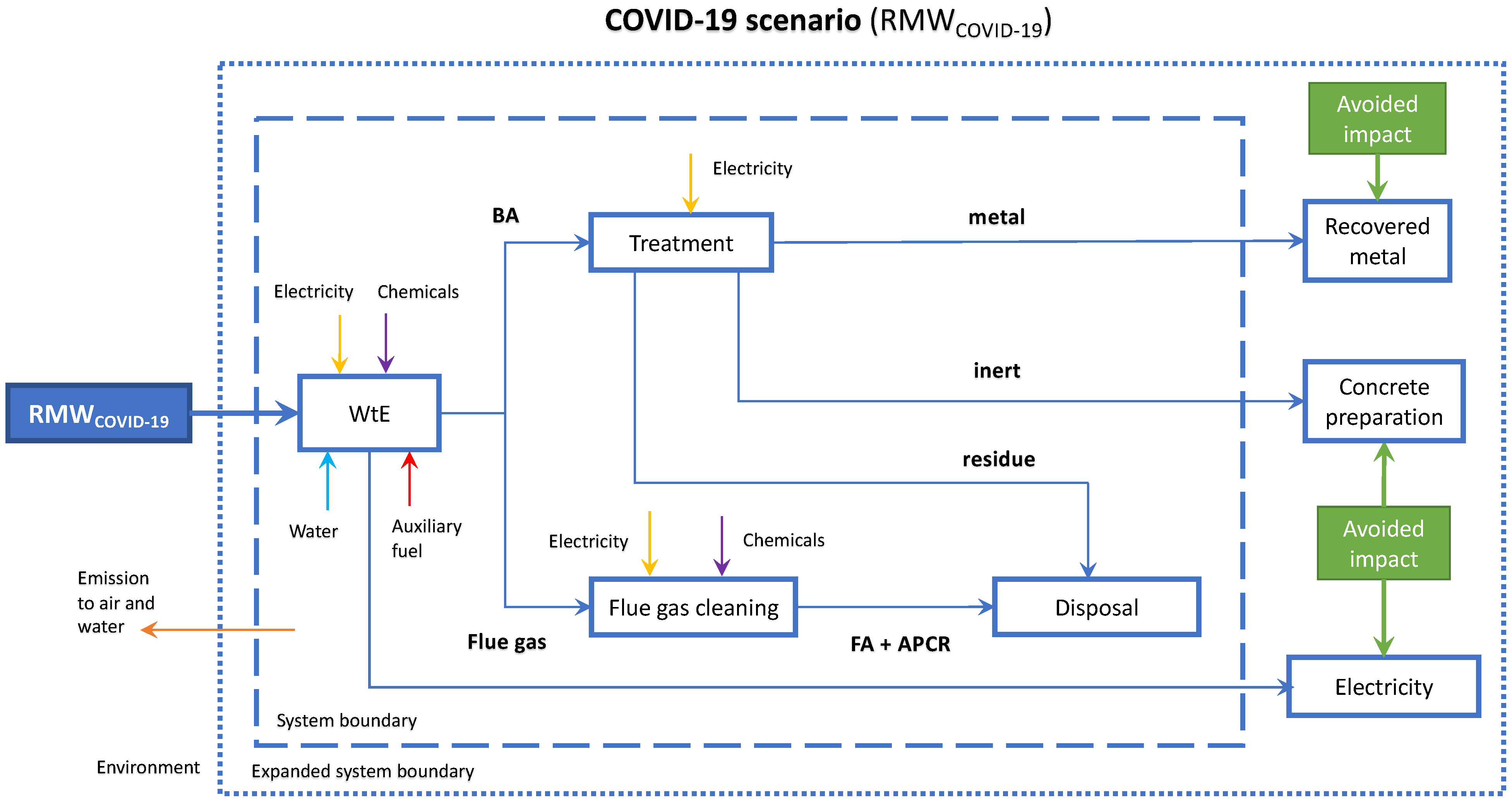
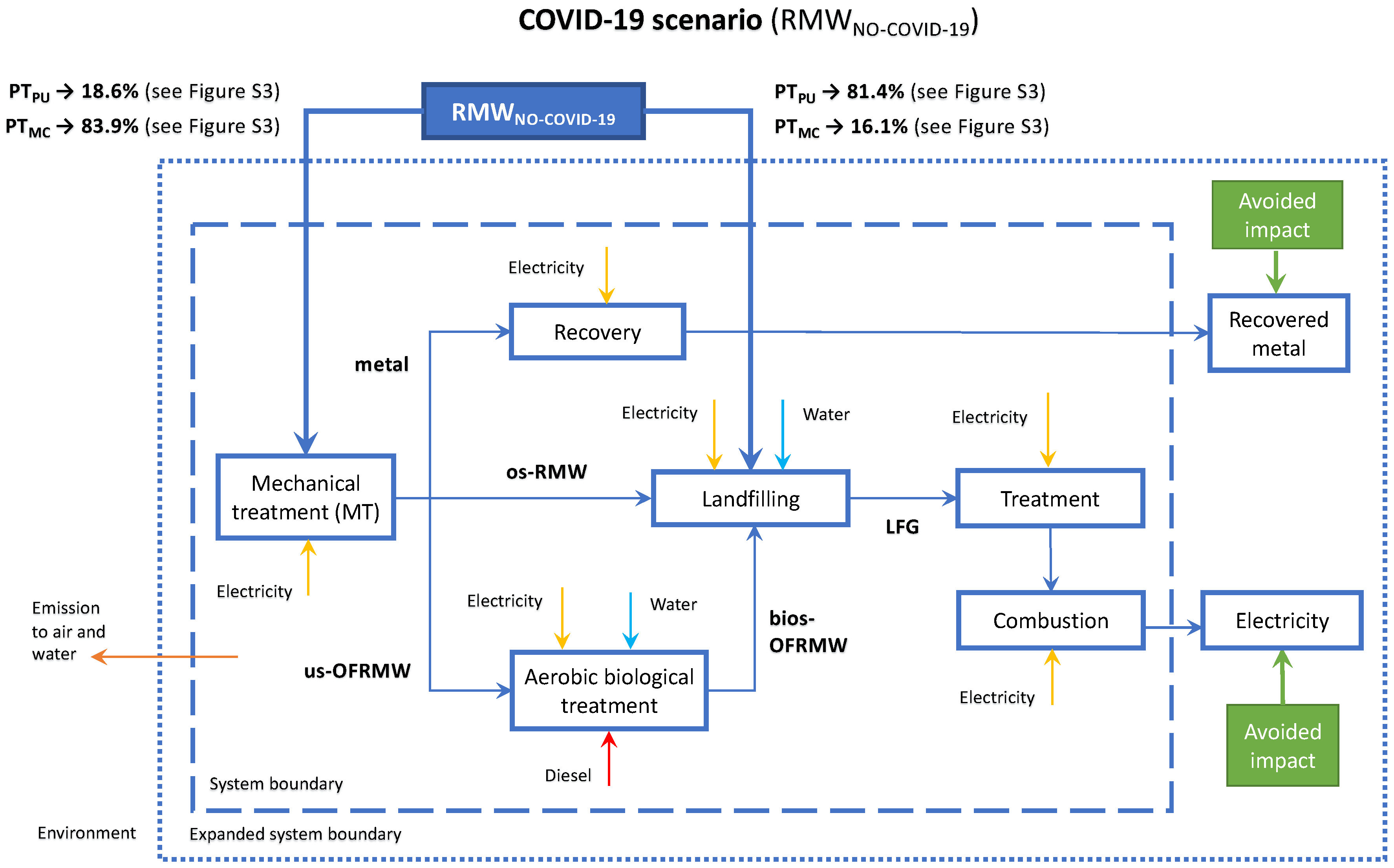
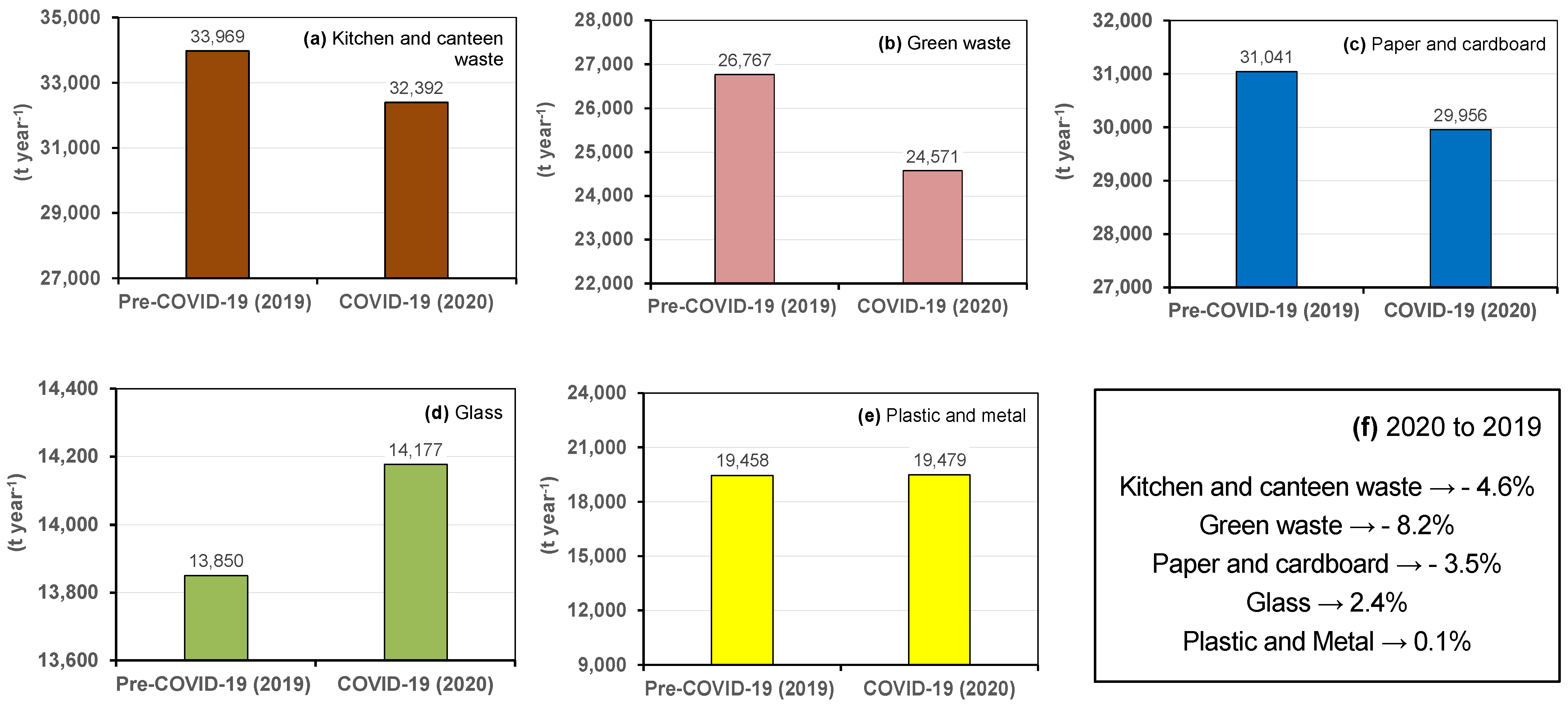



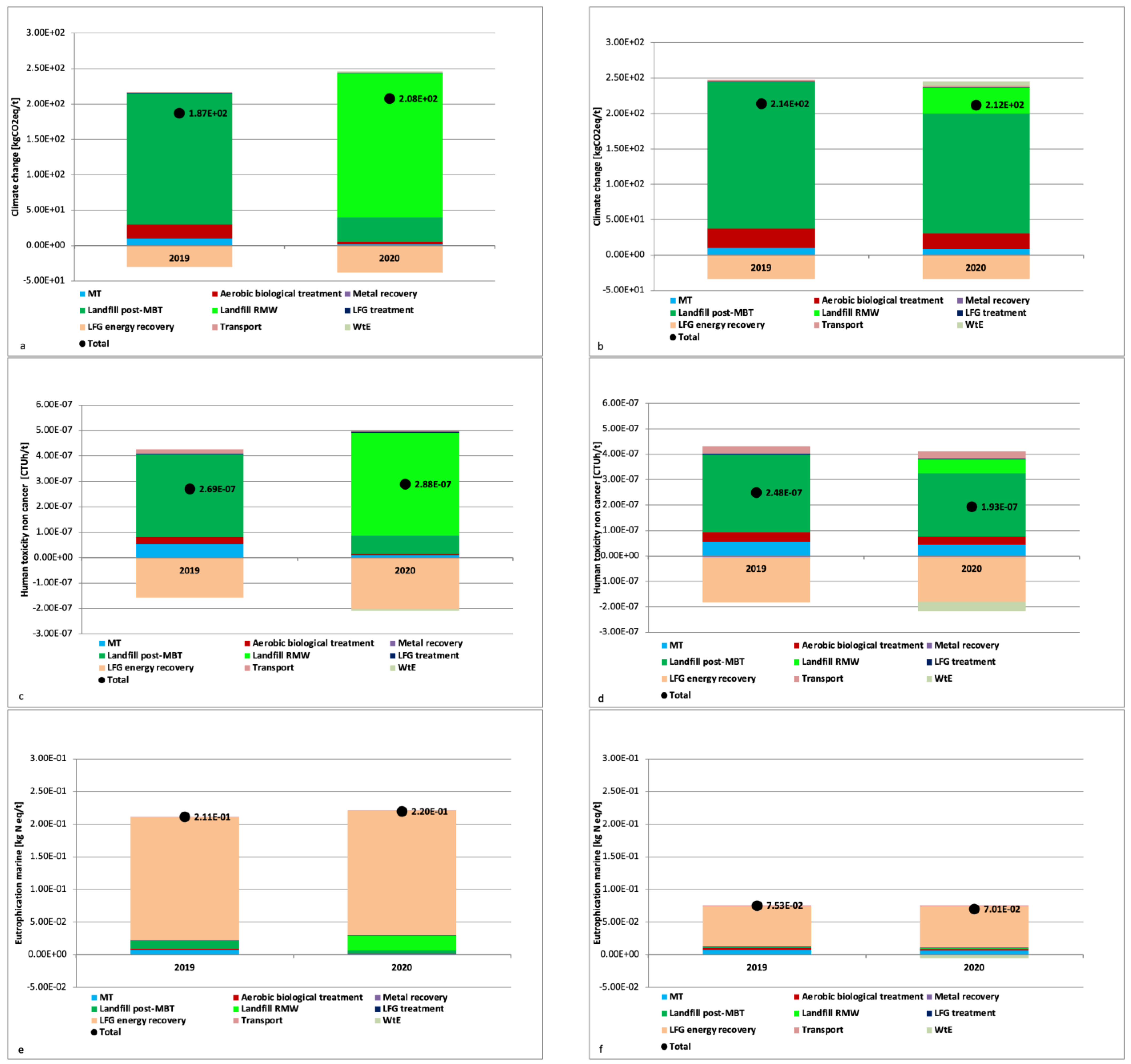

| PTPU | PTMC | Unit | ||
|---|---|---|---|---|
| MT | EE consumption | 2.38E+01 | 2.38E+01 | kWh t−1 |
| os-RMW | 7.81E-01 | 6.91E-01 | t t−1 | |
| us-OFRMW | 2.19E-01 | 3.09E-01 | t t−1 | |
| Metal | 0.00E+00 | 2.94E-04 | t t−1 | |
| Metal recovery | Recovered metal | 0.00E+00 | 2.94E-01 | kg t−1 |
| Secondary raw metal | 0.00E+00 | 2.59E-01 | kg t−1 | |
| Aerobic biological treatment | EE consumption | 4.07E+00 | 5.74E+00 | kWh t−1 |
| Water consumption | 8.28E+00 | 1.17E+01 | kg t−1 | |
| Diesel consumption | 1.78E-01 | 2.51E-01 | kg t−1 | |
| bios-OFRMW | 1.33E-01 | 2.54E-01 | t t−1 | |
| Leachate | 0.00E+00 | 2.78E-02 | m3 t−1 | |
| Losses | 8.60E-02 | 2.45E-02 | m3 t−1 | |
| Aqueous waste | 0.00E+00 | 2.45E-03 | m3 t−1 | |
| Air emissions | CO2 | 1.84E-01 | 2.59E-01 | kg t−1 |
| CH4 | 2.52E-01 | 3.55E-01 | kg t−1 | |
| N2O | 2.85E-02 | 4.01E-02 | kg t−1 | |
| NH3 | 1.22E-03 | 1.72E-03 | kg t−1 | |
| VOCs | 4.60E-02 | 6.48E-02 | kg t−1 | |
| H2S | 1.35E-04 | 1.90E-04 | kg t−1 |
| PTPU | PTMC | Unit | ||||
|---|---|---|---|---|---|---|
| Upper Coastal Landfill | Lower Coastal Landfill | Inland Landfill | ||||
| Transport us-OFRMW | 5.40E+00 | 4.38E+00 | - | - | t km t−1 | |
| Transport bios-OFRMW | 3.28E+00 | 2.66E+00 | - | - | t km t−1 | |
| Transport os-RMW + bios-OFRMW | - | - | - | 2.55E+01 | t km t−1 | |
| Landfilling | EE consumption | 9.36E-01 | 5.10E-01 | 1.11E-01 | 1.61E+00 | kWh t−1 |
| Water consumption | 5.30E+00 | 2.89E+00 | 6.31E-01 | 9.12E+00 | kg t−1 | |
| Leachate | 8.38E-02 | 1.01E-01 | 3.95E-01 | 5.27E-02 | t t−1 | |
| LFG production | 3.72E+01 | 2.70E+01 | 4.94E+00 | 7.85E+01 | m3 t−1 | |
| LFG collection | 2.83E+01 | 2.05E+01 | 3.76E+00 | 5.96E+01 | m3 t−1 | |
| LFG diffuse emissions | 8.93E+00 | 6.47E+00 | 1.19E+00 | 1.88E+01 | m3 t−1 | |
| CH4 production | 1.36E+01 | 7.41E+00 | 1.62E+00 | 2.53E+01 | kg t−1 | |
| CH4 collection | 1.03E+01 | 5.63E+00 | 1.23E+00 | 1.92E+01 | kg t−1 | |
| CH4 diffuse emissions | 3.26E+00 | 1.78E+00 | 3.89E-01 | 6.08E+00 | kg t−1 | |
| LFG cooling | EE consumption | 7.54E-01 | 5.46E-01 | 1.00E-01 | 1.59E+00 | kWh t−1 |
| LFG energy recovery | EE consumption | 1.27E+00 | 6.95E-01 | 1.52E-01 | 2.37E+00 | kWh t−1 |
| Gross EE production | 4.25E+01 | 2.32E+01 | 5.06E+00 | 7.91E+01 | kWh t−1 | |
| Net EE production | 4.12E+01 | 2.25E+01 | 4.91E+00 | 7.68E+01 | kWh t−1 | |
| Exhaust gas | 4.84E+02 | 6.96E+02 | 2.72E+02 | 6.03E+02 | m3 t−1 | |
| Components in LFG diffuse emissions | CH4 | 3.26E+00 | 1.78E+00 | 3.89E-01 | 6.08E+00 | kg t−1 |
| CO2 | 5.82E+00 | 3.49E+00 | 7.85E-01 | 1.16E+01 | kg t−1 | |
| H2S | 4.91E-05 | 9.82E-04 | 1.80E-04 | 1.91E-03 | kg t−1 | |
| HCl | - | 4.92E-06 | 8.01E-08 | 7.91E-06 | kg t−1 | |
| HF | - | 2.07E-06 | 2.75E-07 | 5.27E-06 | kg t−1 | |
| SO2 | - | 3.69E-04 | 1.03E-03 | 8.68E-03 | kg t−1 | |
| CO | 8.48E-05 | - | - | 1.79E-04 | kg t−1 | |
| NH3 | 1.35E-04 | 2.47E-04 | 1.15E-06 | 3.41E-04 | kg t−1 | |
| Components in ICE exhaust gas | PM | 3.75E-05 | 7.31E-05 | 1.36E-05 | 4.68E-05 | kg t−1 |
| NO2 | 1.78E-01 | 2.67E-01 | 9.58E-02 | 2.22E-01 | kg t−1 | |
| CO | 7.97E-02 | 1.64E-01 | 2.53E-02 | 9.92E-02 | kg t−1 | |
| TOC | 4.31E-02 | 8.57E-02 | 1.50E-02 | 5.37E-02 | kg t−1 | |
| SO2 | 3.03E-02 | 5.57E-02 | 1.23E-02 | 3.77E-02 | kg t−1 | |
| HCl | 3.74E-04 | 8.11E-04 | 1.03E-04 | 4.66E-04 | kg t−1 | |
| HF | 1.39E-04 | 2.96E-04 | 4.08E-05 | 1.73E-04 | kg t−1 | |
| PTPU | PTMC | Unit | |
|---|---|---|---|
| Transport RMWCOVID-19 | 2.33E-01 | 4.28E+00 | t km t−1 |
| Diesel consumption for energy | 1.12E-03 | 5.58E-03 | kWh t−1 |
| Diesel consumption for handling | 4.64E-05 | 2.31E-04 | kg t−1 |
| Methane consumption for energy | 2.12E-01 | 1.06E+00 | kWh t−1 |
| Water consumption | 2.30E+00 | 1.15E+01 | kg t−1 |
| EE consumption from grid | 4.51E-02 | 2.24E-01 | kWh t−1 |
| EE self-consumption | 6.00E-01 | 2.99E+00 | kWh t−1 |
| Gross EE production | 5.50E+00 | 2.73E+01 | kWh t−1 |
| NaOH consumption | 1.58E-05 | 7.85E-05 | kg t−1 |
| NaClO consumption | 1.18E-05 | 5.89E-05 | kg t−1 |
| NaHCO3 consumption | 3.75E-02 | 1.86E-01 | kg t−1 |
| Ca(OH)2 consumption | 4.62E-02 | 2.30E-01 | kg t−1 |
| High efficiency Ca(OH)2 consumption | 8.95E-03 | 4.45E-02 | kg t−1 |
| Activated carbon consumption | 2.36E-03 | 1.18E-02 | kg t−1 |
| NH3 consumption | 1.40E-02 | 6.96E-02 | kg t−1 |
| Flue gas | 2.87E+01 | 1.43E+02 | m3 t−1 |
| BA to disposal | 1.17E-03 | 5.83E-03 | kg t−1 |
| EE consumption for BA treatment | 4.21E-03 | 2.09E-02 | kWh t−1 |
| Inert from BA to recovery | 7.90E-01 | 3.93E+00 | kg t−1 |
| Gravel substitution | 3.16E-01 | 1.57E+00 | kg t−1 |
| Sand substitution | 4.74E-01 | 1.94E-01 | kg t−1 |
| Inert from BA to disposal | 2.45E-01 | 1.22E+00 | kg t−1 |
| Secondary raw metal | 1.50E-02 | 7.49E-02 | kg t−1 |
| FA + APCR | 2.60E-01 | 1.30E+00 | kg t−1 |
| Aqueous liquid waste | 2.42E-05 | 1.21E-04 | m3 t−1 |
| CO air emission | 2.72E-04 | 1.35E-03 | kg t−1 |
| NOx air emission | 1.63E-03 | 8.13E-03 | kg t−1 |
| N2O air emission | 6.43E-05 | 3.20E-04 | kg t−1 |
| SOx air emission | 4.68E-05 | 2.33E-04 | kg t−1 |
| PM air emission | 1.29E-05 | 6.44E-05 | kg t−1 |
| HCl air emission | 6.55E-05 | 3.26E-04 | kg t−1 |
| HF air emission | 1.44E-06 | 7.15E-06 | kg t−1 |
| TOC air emission | 2.61E-05 | 1.30E-04 | kg t−1 |
| NH3 air emission | 1.09E-05 | 5.43E-05 | kg t−1 |
| Hg air emission | 3.45E-09 | 1.72E-08 | kg t−1 |
| Cd+TI air emission | 7.18E-09 | 3.58E-08 | kg t−1 |
| Metals air emission | 4.60E-08 | 2.29E-07 | kg t−1 |
| PAH air emission | 8.04E-10 | 4.00E-09 | kg t−1 |
| PCDD/F air emission | 2.87E-14 | 1.43E-13 | kg t−1 |
| PCB-DL air emission | 6.32E-15 | 3.15E-14 | kg t−1 |
| Non-renewable CO2 air emission | 3.56E+00 | 1.69E+01 | kg t−1 |
| PTPU | PTMC | Unit | ||
|---|---|---|---|---|
| MT | EE consumption | 4.39E+00 | 1.94E+01 | kWh t−1 |
| os-RMW | 1.44E-01 | 5.64E-01 | t t−1 | |
| us-OFRMW | 4.04E-02 | 2.52E-01 | t t−1 | |
| Metal | 0.00E+00 | 2.40E-04 | t t−1 | |
| Metal recovery | Recovered metal | 0.00E+00 | 2.40E-04 | kg t−1 |
| Secondary raw metal | 0.00E+00 | 2.12E-01 | kg t−1 | |
| Aerobic biological treatment | EE consumption | 7.52E-01 | 4.69E+00 | kWh t−1 |
| Water consumption | 1.53E+00 | 9.53E+00 | kg t−1 | |
| Diesel consumption | 3.28E-02 | 2.05E-01 | kg t−1 | |
| bios-OFRMW | 2.45E-02 | 2.07E-01 | t t−1 | |
| Leachate | 0.00E+00 | 2.27E-02 | m3 t−1 | |
| Losses | 1.59E-02 | 2.00E-02 | m3 t−1 | |
| Aqueous waste | 0.00E+00 | 2.00E-03 | m3 t−1 | |
| Air emissions | CO2 | 3.39E-02 | 2.12E-01 | kg t−1 |
| CH4 | 4.65E-02 | 2.90E-01 | kg t−1 | |
| N2O | 5.25E-03 | 3.28E-02 | kg t−1 | |
| NH3 | 2.25E-04 | 1.41E-03 | kg t−1 | |
| VOCs | 8.49E-03 | 5.29E-02 | kg t−1 | |
| H2S | 2.48E-05 | 1.55E-04 | kg t−1 |
| PTPU | PTMC | Unit | ||||
|---|---|---|---|---|---|---|
| Upper Coastal Landfill | Lower Coastal Landfill | Inland Landfill | ||||
| Transport us-OFRMW | 8.06E-01 | 7.70E-01 | - | - | t km t−1 | |
| Transport bios-OFRMW | 4.90E-01 | 4.68E-01 | - | - | t km t−1 | |
| Transport os-RMW + bios-OFRMW | - | - | - | 2.08E+01 | t km t−1 | |
| Landfilling | EE consumption | 7.68E-01 | 5.75E-01 | 3.25E-01 | 1.58E+00 | kWh t−1 |
| Water consumption | 4.35E+00 | 3.26E+00 | 1.84E+00 | 8.96E+00 | kg t−1 | |
| Leachate | 6.87E-02 | 1.14E-01 | 1.15E+00 | 5.18E-02 | t t−1 | |
| LFG production | 3.65E+01 | 3.65E+01 | 1.72E+01 | 7.79E+01 | m3 t−1 | |
| LFG collection | 2.77E+01 | 2.78E+01 | 1.31E+01 | 5.92E+01 | m3 t−1 | |
| LFG diffuse emissions | 8.76E+00 | 8.76E+00 | 4.14E+00 | 1.87E+01 | m3 t−1 | |
| CH4 production | 1.33E+01 | 1.00E+01 | 5.65E+00 | 2.51E+01 | kg t−1 | |
| CH4 collection | 1.01E+01 | 7.63E+00 | 4.29E+00 | 1.91E+01 | kg t−1 | |
| CH4 diffuse emissions | 3.20E+00 | 2.41E+00 | 1.35E+00 | 6.03E+00 | kg t−1 | |
| LFG cooling | EE consumption | 7.40E-01 | 7.40E-01 | 3.49E-01 | 1.58E+00 | kWh t−1 |
| LFG energy recovery | EE consumption | 1.25E+00 | 9.41E-01 | 5.29E-01 | 2.36E+00 | kWh t−1 |
| Gross EE production | 4.17E+01 | 3.14E+01 | 1.76E+01 | 7.86E+01 | kWh t−1 | |
| Net EE production | 4.04E+01 | 3.04E+01 | 1.71E+01 | 7.62E+01 | kWh t−1 | |
| Exhaust gas | 5.04E+02 | 7.25E+02 | 2.83E+02 | 6.15E+02 | m3 t−1 | |
| Components in LFG diffuse emissions | CH4 | 3.20E+00 | 2.41E+00 | 1.35E+00 | 6.03E+00 | kg t−1 |
| CO2 | 5.71E+00 | 4.73E+00 | 2.74E+00 | 1.15E+01 | kg t−1 | |
| H2S | 4.82E-05 | 1.33E-03 | 6.27E-04 | 1.89E-03 | kg t−1 | |
| HCl | - | 6.66E-06 | 2.79E-07 | 7.85E-06 | kg t−1 | |
| HF | - | 2.80E-06 | 9.57E-07 | 5.24E-06 | kg t−1 | |
| SO2 | - | 5.00E-04 | 3.58E-03 | 8.62E-03 | kg t−1 | |
| CO | 8.32E-05 | - | - | 1.78E-04 | kg t−1 | |
| NH3 | 1.33E-04 | 3.34E-04 | 4.01E-06 | 3.38E-04 | kg t−1 | |
| Components in ICE exhaust gas | PM | 3.91E-05 | 7.61E-05 | 1.42E-05 | 4.76E-05 | kg t−1 |
| NO2 | 1.85E-01 | 2.78E-01 | 9.97E-02 | 2.26E-01 | kg t−1 | |
| CO | 8.29E-02 | 1.71E-01 | 2.63E-02 | 1.01E-01 | kg t−1 | |
| TOC | 4.49E-02 | 8.91E-02 | 1.56E-02 | 5.47E-02 | kg t−1 | |
| SO2 | 3.15E-02 | 5.80E-02 | 1.27E-02 | 3.84E-02 | kg t−1 | |
| HCl | 3.89E-04 | 8.44E-04 | 1.08E-04 | 4.75E-04 | kg t−1 | |
| HF | 1.45E-04 | 3.08E-04 | 4.25E-05 | 1.77E-04 | kg t−1 | |
| Category | Indicator Unit | PTPU | PTMC | ||||
|---|---|---|---|---|---|---|---|
| Pre-COVID-19 (2019) | COVID-19 (2020) | ∆% 1 | Pre-COVID-19 (2019) | COVID-19 (2020) | ∆% 1 | ||
| Climate change | (kg CO2 eq t−1) | 1.87E+02 | 2.08E+02 | 11.2% | 2.14E+02 | 2.12E+02 | −0.9% |
| Ozone depletion | (kg CFC-11 eq t−1) | −2.03E-06 | −5.54E-06 | −172.9% | −2.19E-06 | −4.29E-06 | −95.9% |
| Ionising radiation | (kBq U235 eq t−1) | −2.03E+00 | −4.89E+00 | −140.9% | −2.36E+00 | −4.23E+00 | −79.2% |
| Photochemical ozone formation | (kg NMVOC eq t−1) | 5.87E-01 | 5.69E-01 | −3.1% | 2.70E-01 | 2.49E-01 | −7.8% |
| Particulate matter | (disease inc. t−1) | 1.57E-06 | 1.22E-06 | −22.3% | 6.07E-07 | 3.55E-07 | −41.5% |
| Human toxicity, non-cancer | (CTUh t−1) | 2.69E-07 | 2.88E-07 | 7.1% | 2.48E-07 | 1.93E-07 | −22.2% |
| Human toxicity, cancer | (CTUh t−1) | −2.15E-09 | −5.34E-09 | −148.4% | −5.36E-09 | −5.83E-09 | −8.8% |
| Acidification | (mol H+ eq t−1) | −1.92E-02 | −1.09E-01 | −467.7% | −5.87E-02 | −1.18E-01 | −101% |
| Eutrophication, freshwater | (kg P eq t−1) | −3.85E-03 | −8.74E-03 | −127% | −5.26E-03 | −8.64E-03 | −64.3% |
| Eutrophication, marine | (kg N eq t−1) | 2.11E-01 | 2.20E-01 | 4.3% | 7.53E-02 | 7.01E-02 | −6.9% |
| Eutrophication, terrestrial | (mol N eq t−1) | 7.06E-01 | 5.76E-01 | −18.4% | 2.13E-01 | 1.30E-01 | −39% |
| Ecotoxicity, freshwater | (CTUe t−1) | −3.76E+00 | −5.12E+01 | −1262% | −2.34E+02 | −4.38E+02 | −87.2% |
| Land use | (Pt t−1) | −2.34E+02 | −5.82E+02 | −148.7% | −2.66E+02 | −4.85E+02 | −82.3% |
| Water use | (m3 depriv. t−1) | −1.32E+01 | −3.07E+01 | −132.6% | −1.47E+01 | −2.43E+01 | −65.3% |
| Resource use, fossils | (MJ t−1) | −2.18E+02 | −5.53E+02 | −153.7% | −2.47E+02 | −4.52E+02 | −83% |
| Resource use, minerals and metals | (kg Sb eq t−1) | −3.36E-05 | −8.02E-05 | −138.7% | −4.39E-05 | −6.55E-05 | −49.2% |
Disclaimer/Publisher’s Note: The statements, opinions and data contained in all publications are solely those of the individual author(s) and contributor(s) and not of MDPI and/or the editor(s). MDPI and/or the editor(s) disclaim responsibility for any injury to people or property resulting from any ideas, methods, instructions or products referred to in the content. |
© 2025 by the authors. Licensee MDPI, Basel, Switzerland. This article is an open access article distributed under the terms and conditions of the Creative Commons Attribution (CC BY) license (https://creativecommons.org/licenses/by/4.0/).
Share and Cite
Boccarossa, M.; Lombardi, L.; Tatàno, F.; Folino, A.; Spadi, V.; Tuci, F.; Sirini, P. COVID-19 Induced Changes in Residual Municipal Waste Management in Provincial Territories of the Marche Region (Italy): Flow Analysis and Environmental Assessment. Recycling 2025, 10, 40. https://doi.org/10.3390/recycling10020040
Boccarossa M, Lombardi L, Tatàno F, Folino A, Spadi V, Tuci F, Sirini P. COVID-19 Induced Changes in Residual Municipal Waste Management in Provincial Territories of the Marche Region (Italy): Flow Analysis and Environmental Assessment. Recycling. 2025; 10(2):40. https://doi.org/10.3390/recycling10020040
Chicago/Turabian StyleBoccarossa, Massimiliano, Lidia Lombardi, Fabio Tatàno, Adele Folino, Valentina Spadi, Francesca Tuci, and Piero Sirini. 2025. "COVID-19 Induced Changes in Residual Municipal Waste Management in Provincial Territories of the Marche Region (Italy): Flow Analysis and Environmental Assessment" Recycling 10, no. 2: 40. https://doi.org/10.3390/recycling10020040
APA StyleBoccarossa, M., Lombardi, L., Tatàno, F., Folino, A., Spadi, V., Tuci, F., & Sirini, P. (2025). COVID-19 Induced Changes in Residual Municipal Waste Management in Provincial Territories of the Marche Region (Italy): Flow Analysis and Environmental Assessment. Recycling, 10(2), 40. https://doi.org/10.3390/recycling10020040









